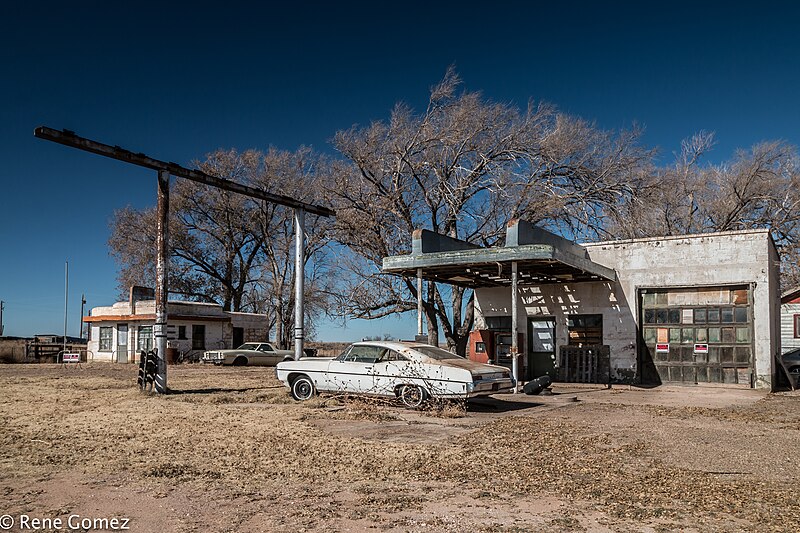Christian M. Mericle, Glenrio NM Tex Cafe, CC BY 3.0
Glenrio’s historical roots are a fascinating blend of cultural influences, reflected in its name derived from the Scottish “glen” and the Spanish “rio.” Founded in 1901 as a railroad town, it never boasted a large population, peaking at fewer than 30 residents. The founding significance of Glenrio lies in its strategic role as a stop on the Rock Island Railroad, which connected larger cities and spurred economic growth in the region.
This situation mirrors the early settlement patterns in Texas, where railroads facilitated the transport of goods and people, much like the economic development and expansion that followed Texas’s statehood. The railroad’s presence was crucial in facilitating the transport of goods, particularly wheat and cattle, which were the area’s main economic activities.
Route 66’s Impact on Glenrio
Route 66 played an essential role in shaping Glenrio’s identity and economy. Situated between Amarillo, Texas, and Tucumcari, New Mexico, Glenrio thrived as a lively stopover for travelers venturing along this iconic highway. The town’s strategic location not only made it a significant link on the Route 66 map but also contributed to the development of local attractions and businesses that catered to the needs of road-weary visitors, showcasing the area’s cultural significance and unique heritage, such as the strong, steady winds prevalent in the Texas Panhandle.
- Tourism Boom: Glenrio became a hub for tourists, relying heavily on the steady stream of Route 66 travelers for its economic survival. Businesses like the dual-state service stations and the famous Initial-Final Motel catered to the needs of road-weary visitors.
- Cultural Relevance: Featured in John Steinbeck’s “The Grapes of Wrath,” Glenrio’s cultural significance rose during the Great Depression, emphasizing its role in American history.
- Economic Decline: The construction of Interstate 40 in the 1970s diverted traffic, leading to a sharp economic downturn for Glenrio as visitors bypassed the town.
- Nostalgic Appeal: The allure of Route 66’s past draws visitors to Glenrio, enthusiastic to investigate its abandoned sites and historical remnants, adding a new chapter to its economic story.

Glenrio Today – Ghost Town Status
As you investigate the remnants of Glenrio, you’ll find yourself walking through the echoes of a once-thriving community now classified as a ghost town. Current demographics paint a stark picture: Glenrio is home to just one resident. This single inhabitant lives amidst the crumbling remains of what was a lively community of around 30 people. The town’s decline started in the 1950s when the Rock Island Railroad depot closed, and the construction of Interstate 40 bypassed Glenrio, diverting the flow of travelers that once fueled its economy.
Iconic Structures and Landmarks
Amidst the desolation of Glenrio, iconic structures and landmarks whisper stories of a bygone period. As you wander through this ghost town, you’ll uncover relics that hint at its once-vibrant life. One such landmark is the dilapidated Texaco station, built in 1950. It’s a haunting reminder of the time when road trips were king, and travelers relied on these pit stops for refueling.
Here are four notable structures and landmarks you can’t miss:
- Texaco Station and Pontiac Relic: In front of the old Texaco station, an abandoned Pontiac stands, a poignant symbol of Glenrio’s lively automotive past.
- Brownlee Diner Remains: Serving meals until 1973, the diner inspired a character design in the movie “Cars.” Its remnants echo the animated gatherings it once hosted.
- State Line Motel: Opened in 1955, this U-shaped motel offered cozy accommodations but now stands as a shadow of its former self, with original furnishings slowly fading away.
- First-Last Sign: Erected in 1955, this sign marked the Texas border, but time has taken its toll, leaving its letters barely legible.
These landmarks paint a vivid picture of Glenrio’s storied past.
Nearby Attractions to Explore
While investigating the ghostly remnants of Glenrio, you’ll find that the surrounding area offers a cache of attractions that complement the town’s historical ambiance. Start your expedition by visiting the World’s Largest Branding Iron, just 34.98 miles away. This landmark celebrates the ranching culture of the Texas Panhandle, providing a unique cultural experience. It’s a perfect stop to engage yourself in the region’s storied past.
For those who appreciate natural wonders, Floating Mesa is a must-see. Located 56.33 miles from Glenrio, this geological marvel offers stunning views that will leave you in awe. The sight of the mesa seemingly floating on the horizon is truly mesmerizing and provides a serene escape from the eerie vibes of the ghost town.

Christian M. Mericle, Glenrio NM Tex Motel 1, CC BY 3.0
Wrapping Up
With its thriving businesses, strategic location, and undeniable charm, it embodied the magic of America’s most famous highway.
Despite its decline, Glenrio’s memory lives on through those who continue to celebrate its history. The town’s perseverance mirrors the enduring spirit of Route 66 itself—a road that refuses to fade entirely into history.


